Unit 7 Quiz/ AP CHEM
1/26
There's no tags or description
Looks like no tags are added yet.
Name | Mastery | Learn | Test | Matching | Spaced |
|---|
No study sessions yet.
27 Terms
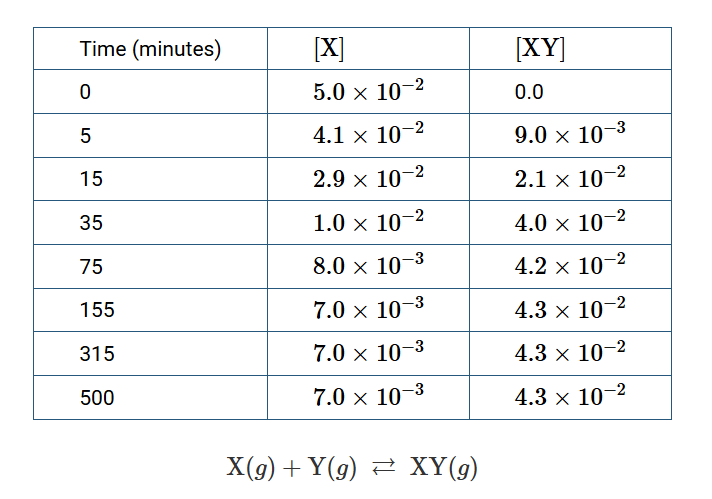
In an experiment, X(g) and Y(g) were combined in a rigid container at constant temperature and allowed to react as shown in the equation above. The table provides the data collected during the experiment. Based on the data, which of the following claims is most likely correct?
A) The reaction was about to reach equilibrium 15 minutes after the reactants were combined because the concentrations of X and XY were almost the same.
B) The reaction reached equilibrium between 75 minutes and 155 minutes after the reactants were combined because the concentrations of X and XY remained constant beyond 155 minutes.
C)The reaction did not reach equilibrium because only 86% of the initial concentration of X was consumed.
D) The reaction did not reach equilibrium because initially there was no XY inside the container.
Answer B
Correct. After 155 minutes, the concentrations of X and XY did not change, indicating that the reaction had reached equilibrium.
![<p>A sample of <span>N<sub>2</sub>O<sub>4</sub>(g)</span> is placed into an evacuated container at <span>373K</span> and allowed to undergo the reversible reaction <span>N</span><sub>2</sub><span>O<sub>4</sub>(g)⇄2NO<sub>2</sub>(g)</span>. The concentration of each species is measured over time, and the data are used to make the graph shown above. Which of the following identifies when equilibrium is first reached and provides a correct explanation?</p><p></p><p><strong>A) </strong>At 14 seconds, because <span>[N</span><sub>2</sub><span>O<sub>4</sub>]</span> is twice <span>[NO</span><sub>2</sub><span>]</span>, which implies that the forward and reverse reaction rates are equal.</p><p><strong>B) </strong>At 23 seconds, because <span>[NO</span><sub>2</sub><span>]</span> equals <span>[N</span><sub>2</sub><span>O<sub>4</sub>]</span>, which shows that equal concentrations are present at equilibrium.</p><p><strong>C) </strong>At 40 seconds, because <span>[NO</span><sub>2</sub><span>]</span> is twice <span>[N</span><sub>2</sub><span>O<sub>4</sub>]</span>, which matches the stoichiometry of the balanced chemical equation.</p><p><strong>D) </strong>At 60 seconds, because <span>[NO</span><sub>2</sub><span>]</span> and <span>[N</span><sub>2</sub><span>O<sub>4</sub>]</span> remain constant, indicating that the forward and reverse reaction rates are equal.</p>](https://knowt-user-attachments.s3.amazonaws.com/f3d5b824-fd78-4c05-9ba0-72ca52113968.png)
A sample of N2O4(g) is placed into an evacuated container at 373K and allowed to undergo the reversible reaction N2O4(g)⇄2NO2(g). The concentration of each species is measured over time, and the data are used to make the graph shown above. Which of the following identifies when equilibrium is first reached and provides a correct explanation?
A) At 14 seconds, because [N2O4] is twice [NO2], which implies that the forward and reverse reaction rates are equal.
B) At 23 seconds, because [NO2] equals [N2O4], which shows that equal concentrations are present at equilibrium.
C) At 40 seconds, because [NO2] is twice [N2O4], which matches the stoichiometry of the balanced chemical equation.
D) At 60 seconds, because [NO2] and [N2O4] remain constant, indicating that the forward and reverse reaction rates are equal.
Answer D
Correct. Equilibrium is established when the forward reaction rate matches the reverse rate, which causes the concentrations of reactants and products to remain constant over time.

A cylinder with a moveable piston is completely filled with a small amount (100 millimoles) of liquid water at a pressure of 1.0atm and a temperature of 80∘C. All the air in the cylinder is excluded. The cylinder is placed in a water bath held at 80∘C. The piston is slowly moved out to expand the volume of the cylinder to 20L as the pressure inside the cylinder is monitored. A plot of the pressure versus volume for the system is shown in the figure above. Which of the following statements most closely indicates, with justification, the region of the curve where the equilibrium represented below occurs?
H2O(l)⇄H2O(g)
A) Region A, because the initial pressure inside the cylinder is equal to the pressure outside the cylinder, so there is no net force on the piston.
B) Region B, because the pressure inside the cylinder is equal to the vapor pressure of water at 80∘C when both liquid and gas phases are present.
C) Region C, because the water vapor is behaving according to the ideal gas law as expansion occurs.
D) Region D, because the pressure inside the cylinder has leveled off.
Answer B
Correct. As expansion occurs, liquid water evaporates reversibly, holding the pressure constant at the equilibrium vapor pressure of water at 80∘C(0.47atm). When all of the liquid has evaporated, the pressure drops and follows the ideal gas law.
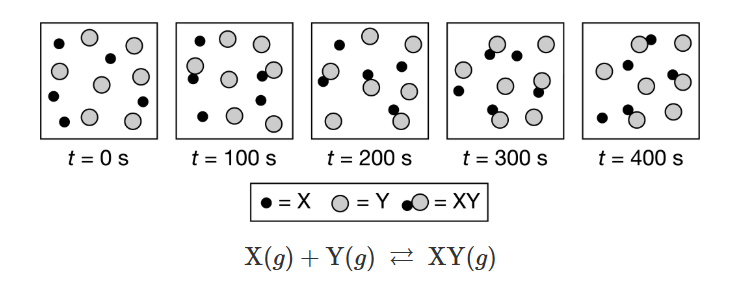
The particle diagram above illustrates the changes that take place when X(g) and Y(g) are placed inside a rigid container at constant temperature. Which of the following is a characteristic of a system at equilibrium that is best represented by the particle diagram?
A) The particle diagram shows that initially the reaction proceeds to the right to form products, which is a characteristic of a system at equilibrium.
B) The particle diagram shows that after 200s the rate of the reverse reaction is slower than the rate of the forward reaction, which is a characteristic of a system at equilibrium.
C) The particle diagram shows that after 200s there are no observable changes in the amounts of reactants and products, which is a characteristic of a system at equilibrium.
D) The particle diagram shows that between 0s and 200s the rates of the forward and reverse reactions are the same, which is a characteristic of a system at equilibrium.
Answer C
Correct. After t=200s, there are no observable changes in the amounts of reactants and products, which is a characteristic of a system at equilibrium.
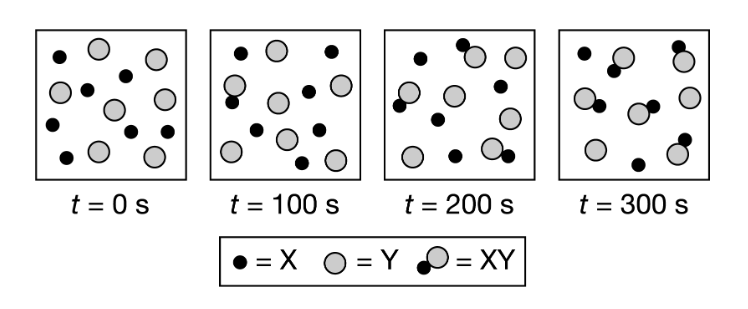
An equimolar mixture of X(g) and Y(g) is placed inside a rigid container at constant temperature. The particle diagram above represents the changes that occur over time. Based on the particle diagram, which of the following best predicts whether or not the system has reached equilibrium by 300s?
A) It is not possible to determine that the system has reached equilibrium by 300s because the stoichiometry of the reaction is not known.
B) It is not possible to determine that the system has reached equilibrium by 300s because the amounts of X, Y, and XY have continued to change.
C) The system has reached equilibrium by 300s because the rate of formation of XY is constant.
D) The system has reached equilibrium by 300s because the rates of consumption of X and Y are equal.
Answer B
Correct. Based on the particle diagram, the system has continued to produce XY. Additional data showing that the amounts of reactants and products have remained constant after 300s would be needed to determine that the system has reached equilibrium.
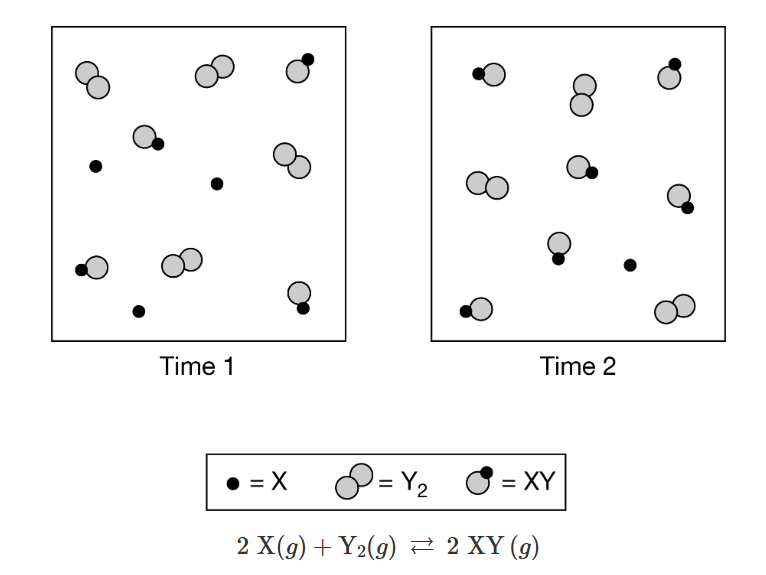
A reversible reaction is represented by the equation above. The amounts of reactants and products at time 1 are shown in the particle diagram on the left. The particle diagram on the right shows the amounts of reactants and products at time 2. Based on the diagrams, what can be inferred about the relative rates of the forward and reverse reactions between time 1 and time 2 ?
A) Nothing can be inferred because the total number of X and Y atoms is the same in each diagram.
B) Nothing can be inferred because the temperature of the system may have been changed.
C) The rate of the reverse reaction is greater than the rate of the forward reaction.
D) The rate of the forward reaction is greater than the rate of the reverse reaction.
Answer D
Correct. After a comparison of the two particle diagrams, it can be concluded that the forward reaction rate was greater than the reverse reaction rate because more product is present at time 2.
![<p><strong>A) </strong><span>[A]<sub>eq</sub></span>, <span>[B]</span><sub>eq</sub>, and <span>[C]</span><sub>eq</sub> will all increase because <span>K<sub>c</sub></span> increased.</p><p><strong>B) </strong><span>[A]</span><sub>eq</sub> and <span>[B]</span><sub>eq</sub> will remain constant, but <span>[C]</span><sub>eq</sub> will increase because <span>K<sub>c</sub></span><sub> </sub>increased.</p><p><strong>C) </strong>There will be a decrease in <span>[A]</span><sub>eq</sub> that will be two times the decrease in <span>[B]</span><sub>eq </sub>because <span>A</span> and <span>B</span> react in a 2-to-1 ratio.</p><p><strong>D) </strong>There will be an increase in <span>[A]</span><sub>eq</sub> that will be two times the increase in <span>[B]</span><sub>eq</sub> because <span>A</span> and <span>B</span> react in a 2-to-1 ratio.</p>](https://knowt-user-attachments.s3.amazonaws.com/7708ed7d-6170-43fa-aaa4-857304b74241.png)
A) [A]eq, [B]eq, and [C]eq will all increase because Kc increased.
B) [A]eq and [B]eq will remain constant, but [C]eq will increase because Kc increased.
C) There will be a decrease in [A]eq that will be two times the decrease in [B]eq because A and B react in a 2-to-1 ratio.
D) There will be an increase in [A]eq that will be two times the increase in [B]eq because A and B react in a 2-to-1 ratio.
Answer C
Correct. Because the value of Kc is larger at the higher temperature, the equilibrium concentrations of the reactants will be lower than those at the lower temperature. Based on the stoichiometry of the reaction, the decrease in [A]eq will be two times the decrease in [B]eq.
note: exo because producs = more means kc increase

A) PI2 ≈ 14 torr, because it is directly proportional to the square of the initial pressure of HI.
B) PI2 ≈ 0.073 torr, because it is inversely proportional to the square of the initial pressure of HI.
C) PI2 ≈ 7.4 torr, because it is directly proportional to the initial pressure of HI.
D) PI2 ≈ 1.9 torr, because it is inversely proportional to the initial pressure of HI.

![<p>The diagram above represents the equilibrium between the two isomers of <span>C<sub>2</sub>H<sub>2</sub>Cl<sub>2</sub></span>, and the table provides the data collected in an experiment to determine its equilibrium constant, <span>K<sub>c</sub></span>, at <span>490K</span>. In a second experiment done at the same temperature, <span>[Z]<sub>eq </sub>≈ 1.0 M</span>. Which of the following is the approximate equilibrium concentration of <span>Y</span> in the second experiment, and why?</p><p></p><p><strong>A) </strong><span>[Y]<sub>eq </sub>≈ 1.4 M</span> because <span>[Y]</span><sub>eq </sub><span>− [Z]</span><sub>eq</sub> should be the same for the same reaction.</p><p><strong>B) </strong><span>[Y]</span><sub>eq </sub><span>≈ 1.5 M</span> because the ratio <span>[Z]</span><sub>eq </sub>/ <span>[Y]</span><sub>eq</sub> should remain constant when the reaction is done at the same temperature.</p><p><strong>C) </strong><span>[Y]eq≈1.6 M</span> because the ratio [Y]<sub>initia</sub>l / [Y]<sub>eq</sub> should remain constant when the reaction is done at the same temperature.</p><p><strong>D) </strong><span>[Y]</span><sub>eq </sub><span>≈ 2.0 M</span> because <span>([Y]<sub>initial </sub>− [Y]</span><sub>eq</sub><span>)=([Z]<sub>initial </sub>− [Z]</span><sub>eq</sub><span>)</span> should be the same for the same reaction.</p>](https://knowt-user-attachments.s3.amazonaws.com/ff0cd8f7-3565-4b4f-8369-7a0838c2d22d.png)
The diagram above represents the equilibrium between the two isomers of C2H2Cl2, and the table provides the data collected in an experiment to determine its equilibrium constant, Kc, at 490K. In a second experiment done at the same temperature, [Z]eq ≈ 1.0 M. Which of the following is the approximate equilibrium concentration of Y in the second experiment, and why?
A) [Y]eq ≈ 1.4 M because [Y]eq − [Z]eq should be the same for the same reaction.
B) [Y]eq ≈ 1.5 M because the ratio [Z]eq / [Y]eq should remain constant when the reaction is done at the same temperature.
C) [Y]eq≈1.6 M because the ratio [Y]initial / [Y]eq should remain constant when the reaction is done at the same temperature.
D) [Y]eq ≈ 2.0 M because ([Y]initial − [Y]eq)=([Z]initial − [Z]eq) should be the same for the same reaction.

![<p>The table above shows data for two reactions carried out in two separate evacuated 1.0-liter rigid containers at constant temperature of <span>298K</span>. To each container <span>0.50mol</span> of the appropriate reactants was added, and the reaction was allowed to reach equilibrium. Based on this information, which of the following correctly compares the relative concentrations of <span>BrCl</span> and <span>NO</span> present inside their respective containers at equilibrium?</p><p></p><p><strong>A) </strong>[BrCl]<sub>eq </sub>= [NO]<sub>eq</sub> because equimolecular mixtures of the reactants were allowed to reach equilibrium at the same constant temperature.</p><p><strong>B) </strong><span>[BrCl]</span><sub>eq </sub><span>> [NO]</span><sub>eq</sub> because <span>Br<sub>2</sub></span> and <span>Cl<sub>2</sub></span> are larger molecules that can collide more frequently to form products.</p><p><strong>C) </strong><span>[BrCl]</span><sub>eq </sub><span>> [NO]</span><sub>eq</sub> because the much larger <span>K</span><sub>eq</sub> for reaction 1 means that a much higher concentration of products will be present at equilibrium for reaction 1 compared with reaction 2.</p><p><strong>D) </strong><span>[BrCl]</span><sub>eq </sub><span>< [NO]</span><sub>eq</sub> because the much larger <span>K</span><sub>eq</sub> for reaction 1 means that hardly any products will be present at equilibrium compared with reaction 2.</p>](https://knowt-user-attachments.s3.amazonaws.com/2fdc6cbc-7e10-4c1f-8873-9489c3d2512a.png)
The table above shows data for two reactions carried out in two separate evacuated 1.0-liter rigid containers at constant temperature of 298K. To each container 0.50mol of the appropriate reactants was added, and the reaction was allowed to reach equilibrium. Based on this information, which of the following correctly compares the relative concentrations of BrCl and NO present inside their respective containers at equilibrium?
A) [BrCl]eq = [NO]eq because equimolecular mixtures of the reactants were allowed to reach equilibrium at the same constant temperature.
B) [BrCl]eq > [NO]eq because Br2 and Cl2 are larger molecules that can collide more frequently to form products.
C) [BrCl]eq > [NO]eq because the much larger Keq for reaction 1 means that a much higher concentration of products will be present at equilibrium for reaction 1 compared with reaction 2.
D) [BrCl]eq < [NO]eq because the much larger Keq for reaction 1 means that hardly any products will be present at equilibrium compared with reaction 2.

At night, an equilibrium reaction between two different nitrogen compounds generates N2O5 in the atmosphere, as represented below.
Reaction 1: NO3(g)+NO2(g)⇄N2O5(g) K=2.6×10−11
A mixture of NO3 and a ten-fold excess of NO2 are placed inside a rigid container at constant temperature and allowed to reach equilibrium. Which of the following provides a correct comparison of the equilibrium concentrations of these chemical species, and why?
A) [N2O5] << [NO3], because a small K value indicates that the consumption of the reactants is favored at equilibrium.
B) [NO2] << [N2O5], because a small K value indicates that the consumption of the reactants is favored at equilibrium.
C) [NO2] << [NO3], because a small K value indicates that the formation of products is not favored at equilibrium.
D) [N2O5] << [NO2], because a small K value indicates that the formation of products is not favored at equilibrium.
Answer D
Correct. As a result of the relatively small K value, the formation of products is not favored when the system is at equilibrium and [N2O5] << [NO2].
HCl(aq)+H2O(l)⇄H3O+(aq)+Cl−(aq)
In 1.0MHCl(aq), HCl is nearly 100 percent dissociated, as represented by the equation above. Which of the following best helps to explain why, in 0.01MHCN(aq), less than 1 percent of HCN is dissociated?
A) The CN− ion is not very soluble in water, and a solid precipitate would form if more of the HCN dissociated.
B) Compared to the HCl(aq) solution, the concentration of the HCN(aq) solution is much too dilute to achieve 100 percent dissociation.
C) The equilibrium constant for the dissociation of HCN(aq) is much smaller than that for the dissociation of HCl(aq).
D) HCN(aq) reacts with water to form a basic solution, and the high concentration of OH−(aq) interferes with the dissociation process.
Answer C
Correct. HCN only dissociates to a small extent, since the equilibrium constant for HCN(aq)+H2O(l)⇄H3O+(aq)+CN−(aq) is much smaller than the equilibrium constant for HCl.

The chemical equations and equilibrium expressions for two reactions at the same temperature are given above. Based on the information, which of the following expressions can be used to calculate the value of K3 for reaction 3 at the same temperature?
A) K3 = (−K1) + (−K2)
B) K3 = (−K1) − (−K2)
C) K3 = K1 × K2
D) K3= (1/K1) × (1/K2)

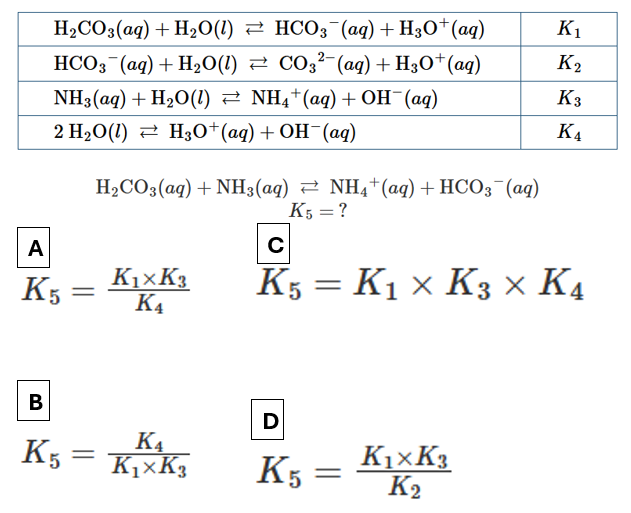
The table above lists some equilibrium systems and their equilibrium constants. Which of the following identifies the correct mathematical relationship that uses the information to calculate K5?


Based on the equilibrium constants given above, which of the following gives the correct expression for the equilibrium constant for reaction 3?

Fe3+(aq)Colorless+ SCN−(aq)Colorless⇄ FeSCN2+(aq)Red
When colorless solutions containing Fe3+(aq) ions and SCN−(aq) ions are combined, a deep-red complex ion, FeSCN2+(aq) quickly forms, as shown in the net ionic equation above. Which of the following explains the observation that adding a few additional crystals of KSCN(s) results in the red color of the solution becoming deeper?
A) The added KSCN(s) dissolves, disturbing the charge balance in the solution, causing Fe(SCN)3 to precipitate as a red solid.
B) The added KSCN(s) dissolves, causing the solution to become saturated in SCN− ions, which appear red at high concentrations.
C) The added KSCN(s) dissolves, causing the reaction system to respond by producing more product to partially consume SCN−(aq) and reduce its concentration.
D) The added KSCN(s) dissolves, causing the reaction system to respond by forming more Fe3+ ions, which have a deep orange color at high concentrations.
Answer C
Correct. By Le Chatelier’s principle, disturbing the equilibrium by adding SCN− ions causes the equilibrium to shift in a way to reduce the concentration of SCN− ions by forming more red FeSCN2+ ions.
At night, an equilibrium reaction between two different nitrogen compounds generates N2O5 in the atmosphere, as represented below.
Reaction 1: NO3(g)+NO2(g)⇄N2O5(g) K=2.6×10−11
In the atmosphere, small water droplets are suspended in the air, forming an aerosol. N2O5(g) can form HNO3(aq) under these conditions, as shown in reaction 2, represented below.
Reaction 2:N2O5(g)+H2O(l)→2HNO3(aq)
Which of the following predicts the effect that the formation of HNO3(aq) will have on the equilibrium shown in reaction 1, and why?
A) The equilibrium of reaction 1 will shift toward the formation of more product, because N2O5(g) is removed when it reacts to form HNO3(aq).
B) The equilibrium of reaction 1 will shift toward the formation of more product, because H2O(l) acts as a catalyst for reaction 1.
C) The equilibrium of reaction 1 will shift toward the formation of more reactants, because the product N2O5(g) is removed when it reacts to form HNO3(aq).
D) The equilibrium of reaction 1 is not affected, because neither H2O(l) nor HNO3(aq) are gases.
Answer A
Correct. The occurrence of reaction 2 decreases the amount of N2O5(g). With the consumption of the product of a reaction, the equilibrium will shift toward the formation of more product, consuming NO2(g) and NO3(g).
At night, an equilibrium reaction between two different nitrogen compounds generates N2O5 in the atmosphere, as represented below.
Reaction 1: NO3(g)+NO2(g)⇄N2O5(g) K=2.6×10−11
During the day, solar radiation is absorbed by NO3(g), resulting in its decomposition. Which of the following best explains whether the equilibrium concentration of N2O5(g) in the atmosphere in the daytime is different from that in the nighttime, and why?
A) [N2O5] will be higher during the day, because the decomposition of NO3(g) results in an increase in the rate of production of N2O5(g).
B) [N2O5] will be higher during the day, because NO2(g) will be in excess, leading to an increase in the rate of production of N2O5(g).
C) [N2O5] will be lower during the day, because the decomposition of NO3(g) in the daytime will result in an increase in the rate of consumption of N2O5(g) to reform NO3(g).
D) [N2O5] will be about the same at nighttime and daytime, because the amount of NO2(g) will not be changed and the equilibrium will not be affected.
Answer C
Correct. During the day, the amount of NO3(g) decreases as it decomposes, and according to Le Châtelier’s principle, the rate of the reverse reaction will increase to replenish the NO3(g) as N2O5(g) is consumed. Therefore, [N2O5] will be higher at night.

The equilibrium reaction between Cl2(aq) and H2O(l) at 25°C is represented by the chemical equation shown above. If a solution at equilibrium at 25°C is diluted with distilled water to twice its original volume, which of the following gives the value for Qc and predicts the response by the system immediately after dilution?
A) Qc = 4Kc, and the rate of the reverse reaction will be greater than the rate of the forward reaction.
B) Qc = 4Kc, and the rate of the forward reaction will be greater than the rate of the reverse reaction.
C) Qc = Kc / 4, and the rate of the reverse reaction will be greater than the rate of the forward reaction.
D) Qc = Kc / 4, and the rate of the forward reaction will be greater than the rate of the reverse reaction.

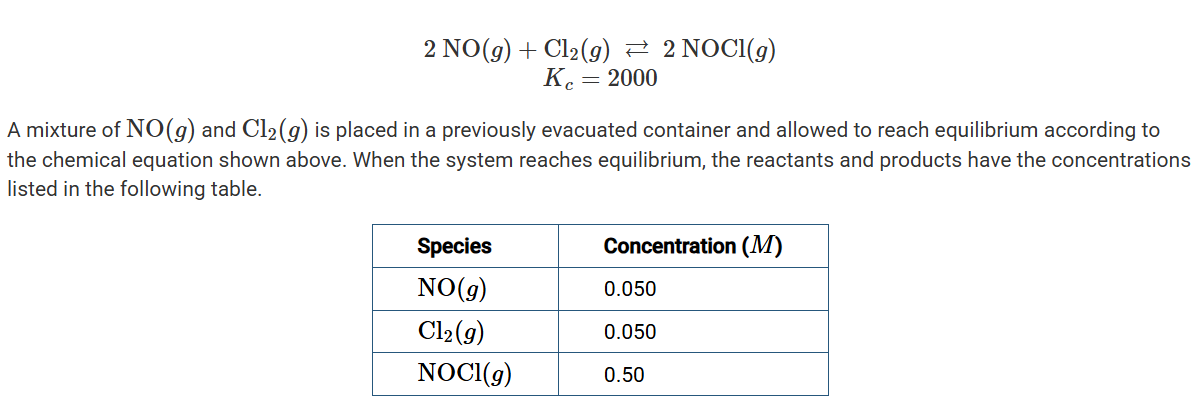
Which of the following is true if the volume of the container is decreased by one half?
A) Q=100, and the reaction will proceed toward reactants.
B) Q=100, and the reaction will proceed toward products.
C) Q=1000, and the reaction will proceed toward reactants.
D) Q=1000, and the reaction will proceed toward products.

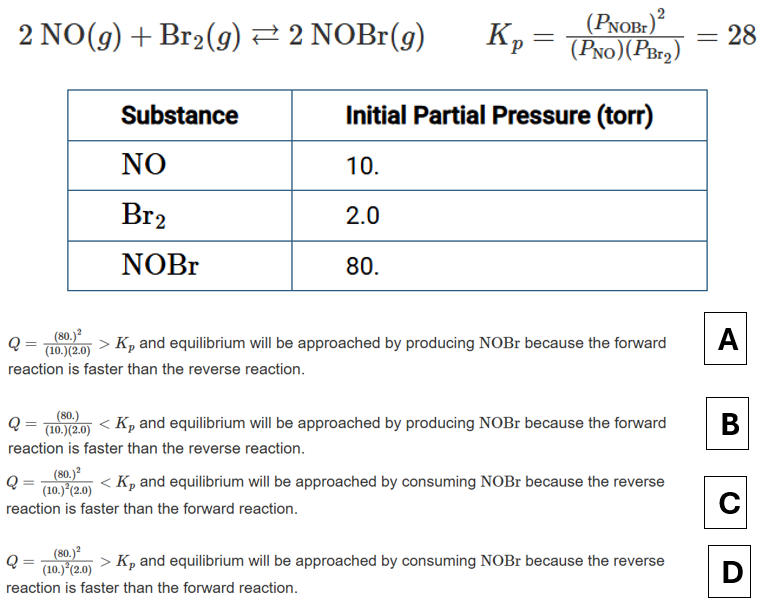
The system represented by the equation above is allowed to establish equilibrium. The initial pressures of the substances are given in the table. Which of the following explains what the system will do as it approaches equilibrium?

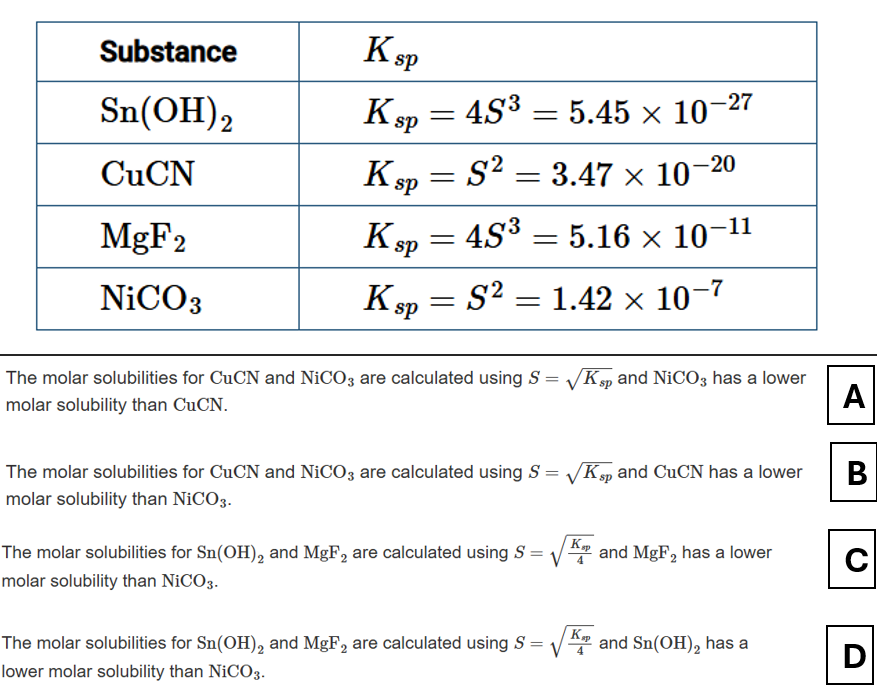
The equilibrium constants for the dissolution (Ksp) of various substances in aqueous solution at 25°C are listed in the table above. Which of the following provides a correct comparison of the molar solubilities (S) of some of these substances based on their Ksp ?
note: you cannot determine solubilty by Ksp, ONLY “S”

Ba(IO3)2(s) ⇄ Ba2+(aq) + 2 IO3−(aq) Ksp=4×10−9
According to the information about the dissolution of Ba(IO3)2(s) shown above, the correct value of S, the molar solubility of Ba(IO3)2(s), can be calculated using with of the following mathematical relationships?
A) ½ S = 4×10−9M
B) 2S = 4×10−9 M
C) S2 = 4×10−9 M
D) 4S3 = 4×10−9 M
Answer D
Correct. Let S be the molar solubility of Ba(IO3)2(s). Substituting into the Ksp expression yields the equation 4×10−9 = (S)(2S)2 = 4S3.
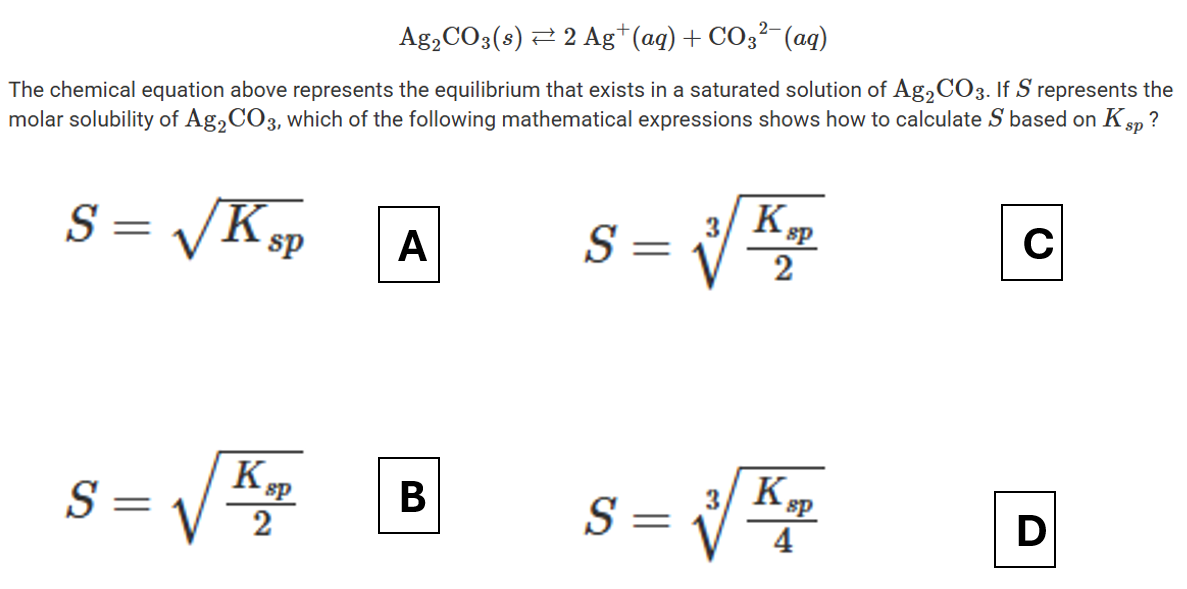

CdF2(s)⇄Cd2+(aq)+2F−(aq)
A saturated aqueous solution of CdF2 is prepared. The equilibrium in the solution is represented above. In the solution, [Cd2+]eq=0.0585M and [F−]eq=0.117M. Some 0.90MNaF is added to the saturated solution. Which of the following identifies the molar solubility of CdF2 in pure water and explains the effect that the addition of NaF has on this solubility?
A) The molar solubility of CdF2 in pure water is 0.0585M, and adding NaF decreases this solubility because the equilibrium shifts to favor the precipitation of some CdF2.
B) The molar solubility of CdF2 in pure water is 0.0585M, and adding NaF has no effect on the solubility because only changes in temperature can increase or decrease the molar solubility of an ionic solid.
C) The molar solubility of CdF2 in pure water is 0.117M, and adding NaF decreases this solubility because the equilibrium shifts to favor the precipitation of some CdF2.
D) The molar solubility of CdF2 in pure water is 0.176M, and adding NaF increases this solubility because the Na+ ions displace the Cd2+ ions, causing the equilibrium to shift to favor the products.
Answer A
Correct. The molar solubility of CdF2 in pure water is equal to the equilibrium concentration of Cd2+ ions in solution, which is 0.0585M. The addition of NaF increases the amount of F− ions in solution, causing a stress to the equilibrium. To minimize the stress, the equilibrium shifts to favor the consumption of the F− ions, which causes some CdF2 to precipitate.
AgCl(s) ⇄ Ag+(aq) + Cl−(aq) Ksp=1.8×10−10
Shown above is information about the dissolution of AgCl(s) in water at 298K. In a chemistry lab a student wants to determine the value of s, the molar solubility of AgCl, by measuring [Ag+] in a saturated solution prepared by mixing excess AgCl and distilled water. How would the results of the experiment be altered if the student mixed excess AgCl with tap water (in which [Cl−]=0.010M) instead of distilled water, and the student did not account for the Cl− in the tap water?
A) The value obtained for Ksp would be too small because Cl−(aq) ions would be attracted to the Ag+ ions in the AgCl crystals, thus preventing water molecules from reaching the crystals.
B) The value obtained for Ksp would be too small because less AgCl(s) would dissolve because of the common ion effect due to the Cl−(aq) already in the water.
C) The value obtained for Ksp would be too large because more AgCl(s) would dissolve because of the attractions between Ag+ ions in the AgCl crystals and the Cl−(aq) ions in the water.
D) The results of the experiment would not be altered because 0.010M is such a small concentration of Cl−(aq) ions and thus has no effect on the dissolution of AgCl(s).
Answer B
Correct. The presence of the common ion Cl−(aq) will cause a change in the equilibrium balance, and fewer Ag+ and Cl ions would go into solution than would go in pure water.
CuBr(s) ⇄ Cu+(aq) + Br−(aq)
Shown above is the chemical equation for the dissolution of the slightly soluble salt CuBr(s). Its Ksp value in pure water was experimentally determined. CuBr was found to be much less soluble in a 0.001MNaBr solution than in pure water. Which of the following correctly explains the decrease in solubility of CuBr in 0.001 M NaBr?
A) The concentration of water is much less in the NaBr solution than in pure water, reducing the rate of dissolution of the salt.
B) The presence of Na+ ions in the solution inhibits the dissolution of salts.
C) The presence of additional Br− already in the solution decreases the value of the for CuBr, causing the solubility to decrease.
D) The presence of additional Br− ions already in the solution means equilibrium will be reached when much less CuBr has dissolved.
Answer D
Correct. The solubility of CuBr is lower in the 0.001MNaBr(aq) solution because there are already Br− ions in solution before the CuBr even starts to dissolve. The rate at which CuBr dissolves will become equal to the rate at which it precipitates when equilibrium is reached, and the solution will be saturated when much less CuBr dissolves compared with pure water.